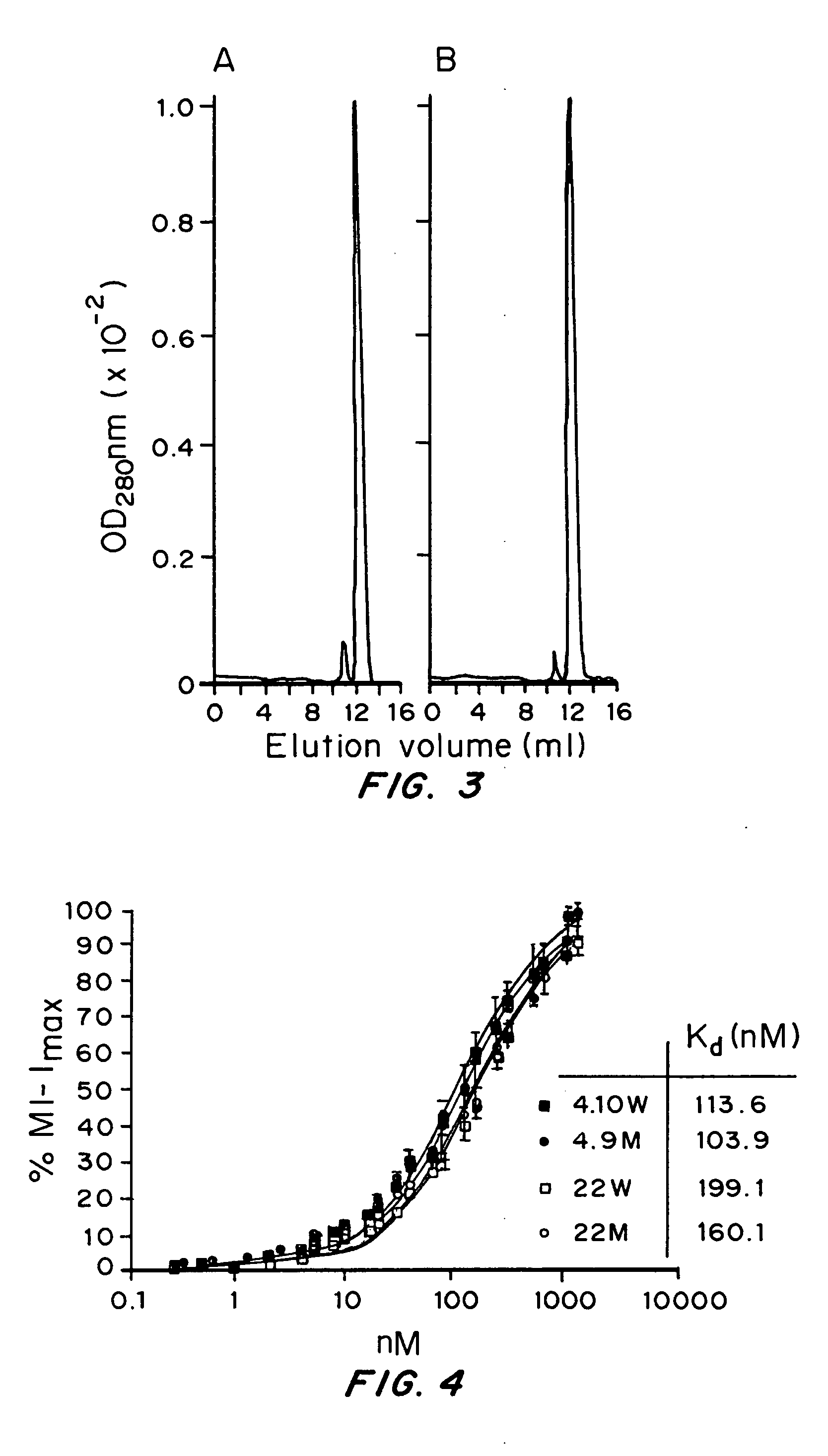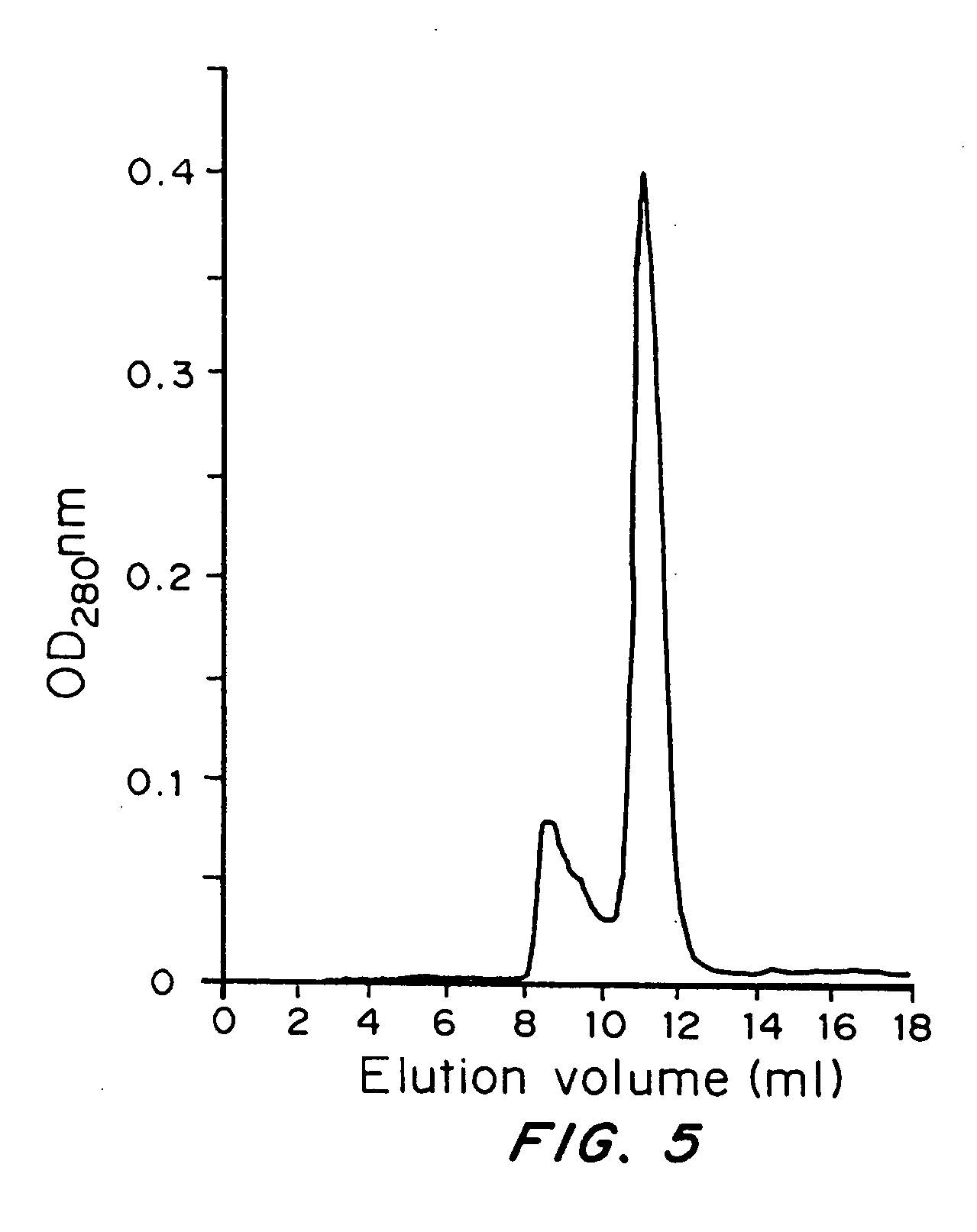Biological materials and uses thereof
a technology of biological materials and antibodies, applied in the field of antibodies, antibody fragments and antibody derivatives, can solve the problems of insufficient enrichment of scfv molecules in xenografted solid tumours in immunodeficient mice, hampering future clinical applications, and too short half-life of scfv's to be of wide clinical use, so as to influence the stability of the whole scfv molecule and minor impact on the affinity of the molecul
- Summary
- Abstract
- Description
- Claims
- Application Information
AI Technical Summary
Benefits of technology
Problems solved by technology
Method used
Image
Examples
example 1
Generating Antibody Derivatives
[0108] Identification of unusual framework residues The identification of non matching “key residues” (Chothia, C. et al. (1989) Nature 342:877) within the human variable domain acceptor antibody framework regions of huHMFG1 and the murine variable domain donor antibody framework regions of HMFG1 was undertaken by manual inspection.
[0109] The Chothia canonical-class assignments of the complementarity determining regions (L1-L3, H1 and H2) of the donor antibody, were determined by screening the sequence against sequence templates of antibody repertoires (http: / / www.bioinf.org.uk / ). Amino acid residues at the VH / VL interface (Chothia et al., 1985, JMB 186, 651-663) were also inspected so as to identify unusual residues with the potential to interfere with VH-VL inter-domain stability.
Generation of Wild Type scFv huHMFG1, scFv Mutants and Diabody
[0110] The huHMFG1 variable light chain was PCR amplified from plasmid pAS 1 (Antisoma Ltd). Plasmid pAS1 ...
example 2
Antibody Fragment Binding
[0135] The selective binding of the constructs was determined by flow cytometry using the human MUC1+ cell lines MCF7 (ATCC # HTB-22) and SKOV-3 (ATCC # HTB-77) Mouse myeloma B cell line Sp2 / 0-Ag14 (ATCC # HTB-77) was used as a negative control. 5×105 cells from each of the test cell lines were incubated with 100 μl of a sample containing either the scFv fragments, or control antibodies, in FACS buffer (PBS, 0.1% NaN3, 2% FBS) for 45 min at 4° C. in round bottom 96-well microtitre plates.
[0136] The test cells were pelleted at 200 g at 4° C. for 5 min and washed twice with 200 μl FACS buffer. For detection of antibodies bound to the test cells, the cells were first incubated for 30 min at 4° C. with saturating concentrations of the anti-c-myc mAb 9E10 (10 μg / ml; Roche), followed by two washes and incubation with saturating amounts of FITC-labelled anti-mouse IgG (13 μg / ml; Jackson Immuno Research, West Grove, Pa.) for 30 min at 4° C.
[0137] In order to excl...
example 3
Antibody Derivative Affinity Constants (Kd) Determination
[0139] Affinity measurements were performed as previously described in the art e.g. Benedict, C. A. et al. (1997) J Immunol Methods 201:223 with the following modifications: Varying concentrations of antibodies (or antibody fragments) were incubated in triplicate with 5×105 MCF7 cells at room temperature in FACS buffer for two hours. Bound antibodies were detected under the same conditions, as described in the section entitled binding assays above.
[0140] After two final washing steps in 200 μl of FACS buffer, the cells were fixed in PBS buffer containing 2% paraformaldehyde for 15 minutes at room temperature and analysed by flow cytometry.
[0141] The median fluorescence intensity (MFI) was determined as described in the binding assays section above and the background fluorescence was subtracted. Equilibrium constants were determined by using the Marquardt-Levenberg algorithm for non-linear regression with the GraphPad Prism ...
PUM
| Property | Measurement | Unit |
|---|---|---|
| flow rate | aaaaa | aaaaa |
| molecular weight | aaaaa | aaaaa |
| pH | aaaaa | aaaaa |
Abstract
Description
Claims
Application Information
 Login to View More
Login to View More - R&D
- Intellectual Property
- Life Sciences
- Materials
- Tech Scout
- Unparalleled Data Quality
- Higher Quality Content
- 60% Fewer Hallucinations
Browse by: Latest US Patents, China's latest patents, Technical Efficacy Thesaurus, Application Domain, Technology Topic, Popular Technical Reports.
© 2025 PatSnap. All rights reserved.Legal|Privacy policy|Modern Slavery Act Transparency Statement|Sitemap|About US| Contact US: help@patsnap.com



